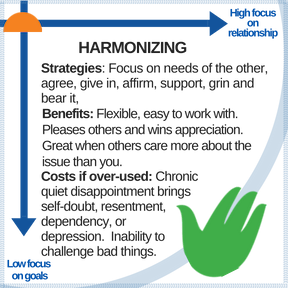 Try using Harmonizing more
Try using Harmonizing more 

You scored lower in this style in Calm settings than other styles. This suggests that in early stages of conflict, when it's just an everyday disagreement and things are not yet emotional, you use Harmonizing less than other styles. This helps you avoid possible weaknesses of the Harmonizing style (such as difficulty in taking a stand on things that matter, or inability to press ahead with important tasks if others challenge you).
But Harmonizing has important strengths you may be missing out on. You'll be most effective in conflict if you are good at all five styles. So increased use of Harmonizing might be beneficial, especially if the gap between your lowish Harmonizing score and your highest score in other styles is 3 or more.
Benefits of Harmonizing. In Harmonizing, you give high priority to the relationship and keeping the other person happy, and a lower priority to tasks or your own agenda. You set aside your own preferences as necessary in order to please the other person and keep the relationship strong. It's not right for all circumstances, but Harmonizing is a wise response sometimes. For example:
- When the other person cares a great deal more about getting their preferences than do you.
- When insisting on your own preferences will damage relationships that are important to you.
- To maintain a balance of give-and-take in a long-term partnerships. If a partner in work or life feels there is not a balance of give and take, resentment creeps in. You can help balance things by using Harmonizing responses more, especially on issues that are not so important to you.
- To bring warmth and joy to any long-term relationship.
Ways to Strengthen Your Use of Harmonizing
To Harmonize you give good attention and support to others and their needs and less to your own. Ways to do that:
- Work on listening skills. Learn "Active Listening" or paraphrasing, and practice until you are good. When you listen well, harmonizing is easier.
- Lighten up. Slow down and inquire about others. Ask questions about things others are likely to enjoy talking about. Smile. Show a sense of humor. Build in some moments for chit-chat or relaxing along with serious discussion.
- Do conflict analysis from the perspective of your counterpart. As sympathetically as you can, make a list in private of your best guess as to the preferences, needs and challenges of a person you are in conflict with. Then look for ways to address them.
- Work on both task and relationship. If you scored low in Harmonizing in Calm, you are probably pretty task focused. To balance this, recognize two challenges in conflict: a) the tasks or issues the conflict is about; and b) the relationship. Make special efforts to support the relationship. For example...
- In negotiations, use a two-step approach to establish a connection before serious work with others. First, connect as people by asking your counterpart how they are doing, inquiring about a family member, thanking them for something, etc. Then, and only then, settle down to business.
Continue to use the other styles as well. But you may wish to experiment with getting more comfortable with Harmonizing, especially in relationships important to you or where connecting has been difficult.



 Need assistance? Email center@riverhouseepress.com with a copy of the login instructions you received and a brief description of what is happening. We'll reply in one business day-usually less.
Need assistance? Email center@riverhouseepress.com with a copy of the login instructions you received and a brief description of what is happening. We'll reply in one business day-usually less. 